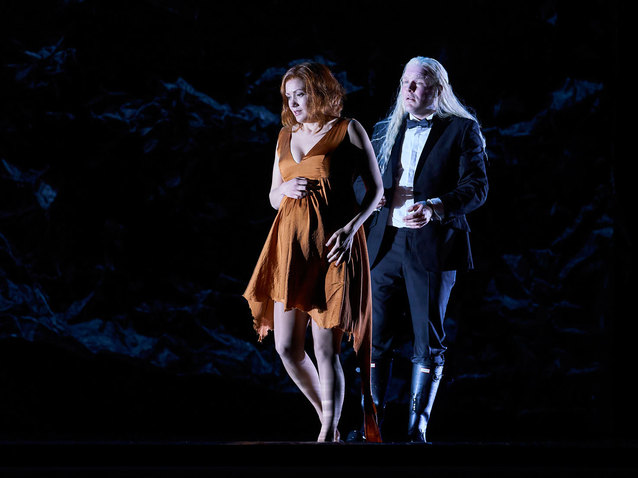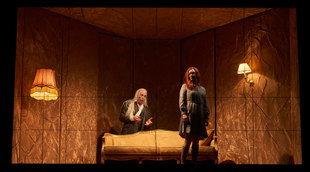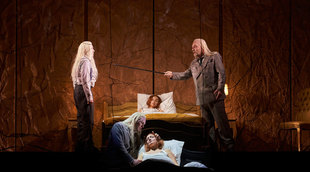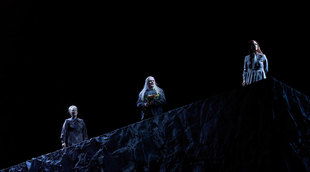 © David Ruano
© David Ruano
Achieving perfection in opera, the most complex form of artistic expression that Western culture has ever created, is not easy, but when it is achieved, the result is magical.
The Pelléas et Mélisande currently on stage at Liceu does not reach perfection but it is very, very close to it and it is more than likely that it will become the great show of the season on an artistic level and will remain for many years in the theatre’s memory.
Everything works at a very high level in this Pélleas. Getting an opera theater orchestra, usually accustomed to a different sonority, to sound ‘as Debussy’ is not easy, but Josep Pons has fully succeeded. In the orchestral sound there was a richness of colours, a floaty sound, transparencies, a delicate balance between sections and nuances, many nuances. The sound of French Impressionist composers’ music is always a matter of nuance.
The orchestra sounded like it hadn't sounded in a long time, and if it was very good in the accompaniment of the singing, it was even better in the interludes that separate the scenes and the acts.
Singing Pélleas is not easy. The text has irregular metrics, and the vocal part often moves between declamation and arioso and moves away from any tradition, French or not. Claude Debussy addressed the singers taking part in the first rehearsal of the opera by saying: “Ladies and gentlemen, this is my Pelléas et Mélisande; you will sing it, but to do so you must forget that you are a singer."
Tenor Stanislas de Barbeyrac completely forgot that he often moves in the Mozartian repertoire and made a very good Pelléas. On stage, he gave the character the kind of daring naiveté that often makes Pélleas look like a kind of French Parsifal.
Julie Fuchs, who was debuting in the character, made an extraordinary Mélisande. Delicate in expression but strong in voice, she placed her character in an exquisite natural sensuality, primordial, without artifice.
Also extraordinary was Simon Keenlyside’s Golaud, his voice worked perfectly in style and diction, but he was also the best actor on stage and filled his ambivalent character with apt subtleties.
Veteran Franz-Josef Selig also made a very complete Arkel both vocally and on stage. Ruth González played the character of little Yniold and made her voice sound totally and appropriately childish and not like a soprano voice.
It was a luxury to have Sarah Connolly for the role of Genèvieve and Stefano Palatchi did a great job as a doctor.
The production, signed by Àlex Ollé, is a revision of the production that he did for the Semperoper of Dresden in 2015, a production that visually has a lot of strength and is dramatically very right.
The set design, by Alfons Flores, shows a symbolic space without any reference to place or time. In the middle of the stage is a huge parallelepiped that, lit from the outside, looks like a rock mass, but when lit from the inside it becomes transparent and shows us rooms that create claustrophobic sensations.
This large structure, which is at the same time a castle, a rock and also a physical and mental prison for its inhabitants, revolves around itself and here one of the few drawbacks of the performance took place. Liceu, which usually solves its stage productions very well technically, this time failed to prevent that when the heavy parallelepiped was turned, the unfortunate cacophonous squeaks that clashed head-on with Debusssy's delicate music could be clearly heard.
All this rotating structure is placed on the stage on a shallow pool of water through which all the characters move. This constant presence of water in the scenery corresponds to the constant mentions of water in the text of the play.
Ollé, in the form of a dreamlike illusion, knows very well how to present all the dark beauty of Pélleas et Mélisande on stage. He gives relevance to the whole powerful symbolic universe of the opera and keeps characters and action in the unsettling ambiguity that permeates this disturbing work that is full of questions and provides no answers.
Xavier Pujol
Barcelona, 28th February 2022
Pelléas et Mélisande by Claude Debussy. Stanislas de Barbeyrac, tenor. Julie Fuchs, soprano. Simon Keenlyside, baritone. Franz-Josef Selig, bass. Ruth González, soprano. Sarah Connolly, mezzosoprano. Stefano Palatchi, bass. Orchestra and Choir of Gran Teatre del Liceu. Conductor, Josep Pons. Stage director, Àlex Ollé. Collaboration in the stage direction, Susana Gómez. Scenography, Alfons Flores. Costumes, Lluc Castells. Lighting, Marco Filibeck. New production by Gran Teatre del Liceu based on the production by Dresden Semperoper.
the 05 of March, 2022 | Print



Comments